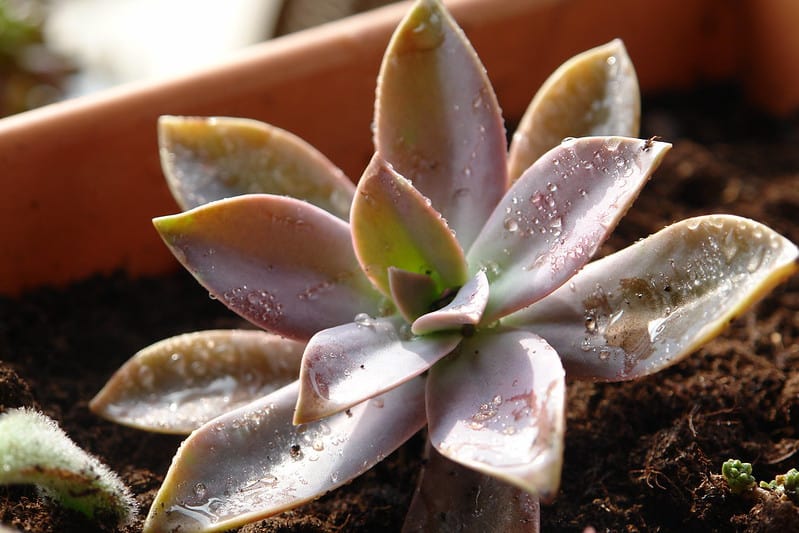Scientific Name: Graptoveria Fred Ives
Common name: Fred
Family: Crassulaceae
Origin: Mexico
Description: It is a hybrid between graptopelatum paraguayense and gibbiflora echeveria. Rosette with elongated and curved leaves, ranging from pale green to purple depending on sun exposure.
It reaches a height of 28cm and the rosette a diameter of 30cm.
Flower: Pale yellow flowers, blooms in spring and lasts until the end of summer.
Cultivation: Full sun or semi-shade, standard compound, moderate irrigation although protect from strong frosts in winter. It is an easy care plant that should not present too many problems.
Fred’ is simply an amazing succulent. It’s normally a pinkish purple color, but can stress to almost any color of the rainbow in heat, cold, or with plenty of sunlight.
You may like silver star
Tips to take care of the Graptoveria “Fred Ives”
Substratum
You need a loose and well-drained soil that contains peat and sand to facilitate drainage of the plant.
The substrate must have a good drainage, since these types of plants are very susceptible to excess water because this can rot the roots and cause death to the plant.
It is also advisable to use akadama or picex. If you can’t get it you can choose to mix universal culture substrate mixed with perlite in equal parts.
Watering
As a general rule, Graptoveria “Fred Ives” should be watered every week or every two weeks during the growing season (summer), depending on the heat and dryness of the air. Watering decreases in winter.
Temperature
If you live in a cold place, move your succulent plant outside in the sunny months and place it in a window where it receives good lighting.
However, remember that they are not frost resistant.
If the temperature starts to fall below 45º F (7º C), you must move it inside your home.
It is a plant that withstand the cold well, but needs protection against frost and, above all, hailstorms.
Propagation
The Graptoveria “Fred Ives” can easily be propagated by cuttings, seeds or offsets.
If you want to grow your Graptoveria “Fred Ives” through cuttings, you only need to remove one blade from the main floor with a sharp knife or scissors.
Then, let the cutting rest for several days before placing it on a floor with good drainage.
And finally, you should only water the new plant, when the soil has dried completely.
If it is through seeds, make sure the temperature is warmer.
Sow the seeds in a soil with good drainage, watering the seeds whenever the soil is dry.
Germination can take several weeks, depending on your growing environment.
The plant will produce small rosette offsets.
You should only cut these offsets from the main stem with a knife or scissors.
Then allow the offsets to dry for a day or two before placing them on a new floor with good drainage.
This plant can also be propagated through a leaf, although the process takes a long time.
Select a leaf for propagation, and gently rotate the leaf from the stem to obtain it with a clean tug, making sure that no part of the leaf remains on the stem.
You should let the leaf become callous for a day or two before placing it on new and well-drained soil.
Transplant
If you sow your Graptoveria “Fred Ives” in a pot, it is important to transplant it every two years to a larger pot.
If I plant the plant directly in the garden this step is not necessary.
Diseases
Its main diseases are excess water in the substrate and / or a humid, poorly ventilated and cold atmosphere, a lot of shade, sunburns, excess dryness and heat.
To prevent rot after rains it is advisable to make the plant treatment with Funcida Copper Cuper Plus (preventive) or Triadimenol 25% 20 CC Blangueta (systematic, preventive and curative).
Toxicity
Graptoveria “Fred Ives” presents no risk to humans or their pets.
Hope this article was helpful if you have any other question please let me know.
I want to suggest you get this plant is very beautiful I’m sure you will enjoy it.
Conclusion
This beautiful succulent is a hybrid between the succulent Graptopelatum Paraguayan and Gibbiflora Echeveria.
It has a rosette shape with elongated and curved leaves, ranging from pale green to purple or pink depending on sun exposure.
It can reach a height of 28 cm and the rosette a diameter of 30 cm.
It is an ideal succulent for outdoors.In full sun the leaves take on more vivid colors, purple or pink.
• It requires moderate watering and must be protected from excessive rain.
• Its flowering is pale yellow. It can be easily reproduced from the leaf, leaflets, stem and plant division.
